Q&A – Ask Neil: June 23, 2022
(Please read these instructions carefully.)
I hope you’re enjoying this new Q&A format. We’re still making minor adjustments, but it’s getting better.
• Click here to post your question.
• After you submit your question, a new window will pop up giving you the address to which you can e-mail a photo to accompany your question. Clear, medium-resolution photos (not thumbnails, please).
• Please only post your question one time.
• One question per reader, please.
• Please use this only for posting questions – not for standard emails.
• Watch for your answer in the following week’s e-gardens.
• I choose those of greatest general interest. For example, plant IDs seldom make the cut.
• I must have your first name or initials.
• I must have your city or county. (Texas is a very large state.)
Question 1
BERMUDA IS YELLOWED AFTER IMAGE.
Question: I use Image to control nutsedge, but it left big patches of my bermuda yellow or dead afterwards. Am I putting on too much? Jean. S., Kennedale.
Answer: I can’t tell without more information, but you can probably determine on your own. Be sure you were using the “original” Image product that was specifically developed for control of nutsedge (“nutgrass”). It was so successful that the manufacturer decided to bring other ingredients into the product for other uses under the same Image umbrella brand name. Second, be sure you applied the amount that you bought to the correct area. Each container will tell you how many square feet it should cover. Third, did you apply copious amounts of water after the application? With Image, unlike with almost any other herbicide, your goal is to soak it into the soil. It must go in through the roots. It acts to retard plant growth, so stunted growth and perhaps even some slight discoloration is normal following its use, but I’ve never seen it kill out lawngrasses in the times that I’ve used it.
Question 2
CRAPE MYRTLE HAS NEVER BLOOMED.
Question: One of my crape myrtles has never produced one bloom. Not one bud. Why? I have 15 in my yard. Kevin O., McKinney.
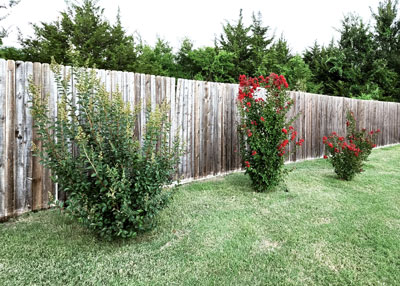
Answer: If you compare the three plants in your photo, the one that isn’t blooming is obviously a different variety. You can see it in its growth form and in the leaf shape, size and color. Crape myrtles’ dates of first blooms will vary from mid-May in McKinney (variety Muskogee blooms first) to late July (Country Red is often the last. That’s just normal genetic difference. If plants are topped, that slows down first bloom by another 6 or 7 weeks. And if they get much shade that may shut down the bloom time entirely. Drive down Eldorado Parkway right now where we in the Crape Myrtle Trails have partnered with the city to plant 8,000 crape myrtles. You’ll see a wide variation in stages of bloom. Be patient. Your plant will bloom. But it’s not going to match the other two in your photo.
Question 3
JAPANESE YEWS DIE ONE BRANCH AT A TIME.
Question: Some of our 2-year-old Japanese yews have recurring problems with branches dying out one at a time. They all have drip irrigation and they get the same sun as the ones next to them. What might be wrong? Elizabeth B., Fort Worth.
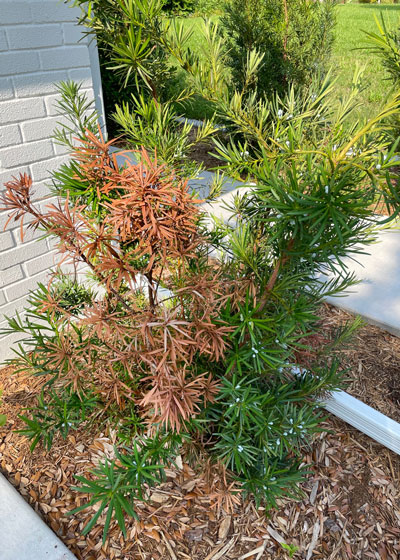
Answer: I doubt if it’s driven by water issues since it’s just one branch from an otherwise healthy plant. I say that, but I don’t have anything better to suggest as an answer. Look closely to see if you find a broken twig that an animal might have brushed into. Just to have said it, I’ve lived in DFW for 52 years and I’ve seen Japanese yews freeze several times this far north. February of 2021 killed them. I know your plants weren’t there then, but maybe this past winter was cold enough to claim part of the damage. They also do better in morning sun and afternoon shade. Watering by hand is always better than drip irrigation with new plants. That way you can really soak them and know that they have been watered thoroughly.
Question 4
OPINIONS ON ARTIFICIAL TURF?
Question: I live in an HOA where mature trees have created problems for turfgrass. We have suggested groundcovers and other shade-tolerant plants, but the latest rage is artificial grass. Do you have any opinions? Brighton G., Southlake.
Answer: I have plenty of opinions, but what I don’t have is a vote. I wouldn’t want artificial grass around my house any more than I’d want an artificial dog curled up beside me on the couch.
Question 5
ODD LITTLE WHITE INSECT
Question: What is this small white insect that is infesting my rose-of-Sharon’s stems for the second year in a row? I’ve sprayed daily with a homemade concoction, but they keep coming back. John B., Abilene.
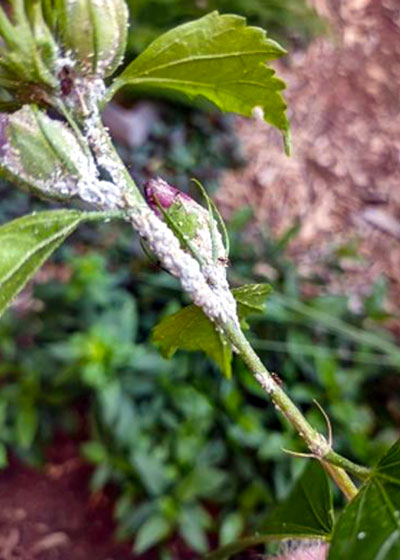
Answer: These are a species of leafhopper (there are scores). They hide within the cottony mass of camouflage they make for themselves. Until you get close to them you really don’t notice that there are living insects within the “cotton.” A general-purpose insecticide will eliminate these very effectively. The reason you’re having to repeat your home “remedy” so often is because it is not really an insecticide. I didn’t repeat the ingredients because I don’t want to encourage others to try things that don’t have legal labels. That’s always been my policy as I explained here last week.
Question 6
HOW TO STOP “FOREST” OF CRAPE MYRTLE SPROUTS.
Question: We have a large crape myrtle 25 years old that is constantly sending up these sprouts from around its base. What can I do to stop them? Laura M., Garland.

Answer: You have so many of them that there has to be an old trunk or major root just beneath the soil line. On a cool, wet day later this fall, use a sharpshooter spade to do some exploratory digging. Cut and remove any large root that may be initiating these. At the same time you could also put down a layer of weed-blocking fabric covered by decorative small river rock to stop them. However, I would not recommend spraying with anything since they are probably tethered to the mama tree.
Question 7
WHY WOULD HARDY HIBISCUS AND HYDRANGEA NOT HAVE BLOOMED YET?
Question: Why would my tropical hibiscus and hydrangeas not have bloomed well this summer? Shirley S., Denison.
Answer: It’s still early for many types of hardy hibiscus – just wait. And as for the hydrangeas, this past winter was cold enough to have done damage, especially clear up by the Red River where you are. Hopefully you didn’t prune them last fall or this past winter. Be patient and things will work out.
Question 8
SHOULD WE KEEP FEEDING CONTAINER PLANTS?
Question: Should I keep feeding my begonias, hibiscus and other patio containers in spite of the really hot weather? Would that be too much? Cindy P., San Antonio.
Answer: Feeding frequency is based on watering frequency. That’s because water dissolves and leaches out the much-needed nutrients. Do not discontinue feeding, even temporarily. Keep water off the foliage if sun will be hitting their leaves. If anything, you could dilute the solution just a bit, perhaps so that you feed at roughly half the normal rate until temperatures break.
Question 9
WHAT TO USE IN PLACE OF EAST PALATKA HOLLIES.
Question: I have three East Palatka hollies that are 8 years old. They are on the low side of the yard so they may be getting too much water. They are losing ground. What evergreen would be good to replace them? Jim B., Little Elm (Denton Co.)
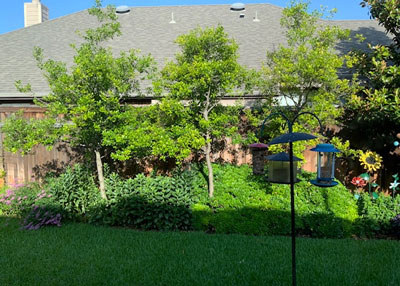
Answer: Nellie R. Stevens hollies, Mary Nell hollies or Oakland Hollies in decreasing order of mature size. As for the East Palatkas, it’s not a matter of too much moisture. It’s a matter of alkaline irrigation water and probably alkaline soil. They are beautiful plants, but they must have acidic conditions and really should never be planted west of the red soils of the East Texas Piney Woods – certainly not in DFW. I love the plant and hope in my next life that I will live where I can grow it.
Question 10
CAN A SMALL MOUNTAIN LAUREL BE MOVED IN LATE SUMMER?
Question: We have a small Texas mountain laurel that we’ve had for 2-plus years (even through the freeze). We may move late this summer. Would it survive begin dug and transplanted in July, August or September? Paul V., Glenn Heights (Ellis County).
Answer: Don’t try it. You would greatly weaken it, or more likely kill it. Leave it as a housewarming gift to the newcomers. Treat yourself to a new plant next spring if you move to an area where they will grow well.
Question 11
WHAT IS WRONG WITH MY DWARF YAUPON HOLLIES?
Question: What has caused my dwarf yaupon holly plants to turn black. I’ve treated them with Neem oil, but it hasn’t helped.
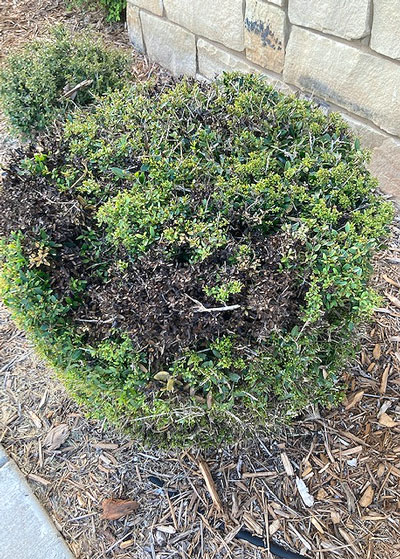
Answer: I’ve had many questions along this same line here and elsewhere this spring but your photo is the most dramatic. I know of no insect or disease that could possibly have done this to your dwarf yaupons. My best guess is that this was done by a large male dog with very bad bathroom manners. Try trimming the plant to tidy it up. Apply a high-nitrogen plant food and water it thoroughly. You should see regrowth fairly quickly if I’m correct.
Question 12
WHAT ONGOING CARE WILL ENCORE AZALEAS NEED?
Question: After amending alkaline soil with sulfur and a tree and shrub mix I planted Encore azaleas, then mulched with pine bark. Besides using azalea fertilizer and adding pine bark each year, is there anything else I need to do to keep my plants thriving? Betty M., Prosper (Collin Co.)
Answer: Here is what I have in the FAQ pages of my website:
“Plant azaleas in a highly organic acidic mixture. In East Texas that can mean little more than adding some peat moss or compost at planting time, but in the rest of the state you’re probably going to need to plant them in 18-inch-deep beds consisting half of sphagnum peat and half of finely ground pine bark mulch. You’ll have to topdress each spring, immediately after they finish blooming, with another 1 or 2 inches of the same mix. Part of the bed should be above the surrounding grade to ensure perfect drainage.”
From what I read in your description, you may not have done that much bed preparation. Soils in Collin County (where I also live and garden) are polar opposite of what azaleas need, so there can be no compromising with this complete changeout of the existing black clay with the mixture of pure organic matter. The rewards are excellent, but the up-front work is significant.
Question 13
HOW TO ELIMINATE THIS LITTLE WEED.
Question: What is this little weed, and how can I get rid of it? I pull it, but it seems to have very few roots. It keeps coming back. Sandra S., Temple.
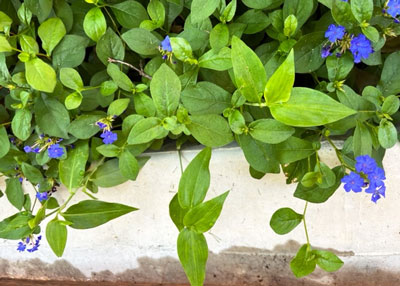
Answer: This is one of the dayflowers (so named because their blooms last only one day). It’s a cousin to purpleheart and wandering Jew, but as you said, it’s not one you want in your flowerbeds. The few times that I’ve had dayflowers get started in my beds I’ve just kept after them by hand-pulling diligently. You mustn’t let them go to seed. You can eventually get ahead of them. You could also use a foam rubber paintbrush dipped into broadleafed weedkiller and them swabbed across the leaves and stems. If you can roll out a weed-blocking landscaping fabric that will also serve to limit their population dramatically. Just keep after them.
Question 14
WHY WOULD ONE CRAPE MYRTLE DIE SUDDENLY?
Question: I have two identical crape myrtles that were planted three years ago. About three weeks ago one of them suddenly dropped most of its leaves. No browning. No spots. It dropped green leaves. What might have caused that? Ken L., Fairview. (Collin Co.)
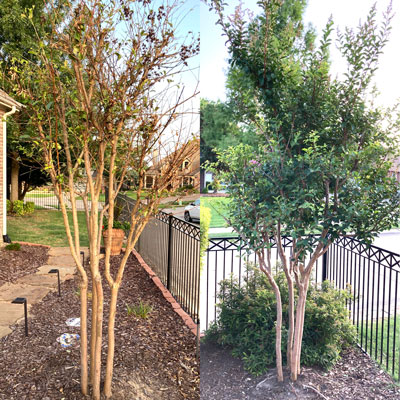
Answer: I’ve grown crape myrtles (hundreds of them) all of my life. The only time I’ve ever seen that happen was when some significant environmental factor popped up. Looking at your photos the thing that came to my mind first was that something might have been applied to the ground inside your fence to kill weeds. Some weedkillers soak into the soil and could have killed the crape myrtle. It’s also possible that your neighbors might have applied something nearby, perhaps even to their driveway to clean it, and that product might have washed into the bed. It just looks like an environmental pollutant. I don’t know of any insect or disease that would impact a crape myrtle in this way. The only exception would be cotton root rot, the soil-borne fungus. However, crape myrtles are normally highly resistant. If you don’t think any weedkiller could have gotten into the soil, it might be worth sending a root sample to the Texas A&M Plant Disease Clinic so that they could examine it for evidence of the soil-borne cotton root rot fungus. There would be a charge for the examination, but that way you would know. Send copies of these two photos with your sample to give them the head start on identifying the source of your problem.
Question 15
WHY HAVE TOMATOES’ LOWER LEAVES TURNED BROWN?
Question: Every year I grow several varieties of tomatoes. They’re in a raised bed with about six hours of sunlight. Every year about now the lower leaves start to turn brown. What do they need? Ann McD., The Colony (Denton Co.)
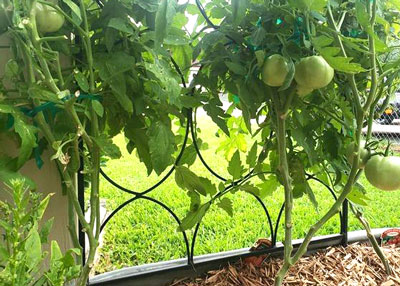
Answer: Two distinctly different problems cause lower leaves to turn colors and fall. I can’t tell for sure from your photo, but I’m guessing spider mites. Early blight (a fungus) hits the lower leaves with bright yellow blotches usually in May. Leaves turn brown and fall. A few weeks later (late May in South Texas and June in North Texas) spider mites will turn the leaves mottled yellow in small speckles. If you thump the leaves over a sheet of white paper you’ll see the nearly microscopic mites start to move about briskly. Use a labeled fungicide on the early blight or labeled insecticide on the mites. This late in the production season I’m not sure how much help you’ll get, however.
Question 16
WHY IS DESERT WILLOW SPARSE AND NOT BLOOMING?
Question: My desert willow was planted 10 months ago. It has sparse, stunted growth with few blooms. It was adequately watered after planting, through the winter and now it gets watered twice weekly with the yard sprinklers. Does it have a problem? Teresa K., Odessa.
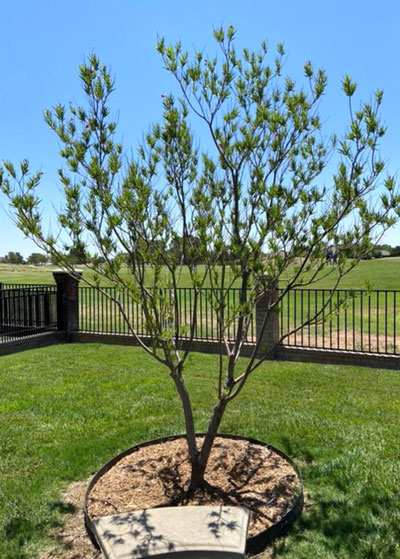
Answer: I’m assuming it was planted from a container. That would mean it had all of its roots intact. It was grown in a lightweight potting soil, so it will dry out much more quickly than the surrounding landscape soil. As you’ll always see me write: sprinkler irrigation is not enough. You need to be soaking it deeply every second or third day. Desert willows grow at the edges of rivers and streams in Southwest Texas, so they’re accustomed to having their roots wet. Add in some high-nitrogen lawn food as well to stimulate new leaf and stem growth.
Question 17
IS GRASS DYING DUE TO TOO LITTLE SUNLIGHT?
Question: I planted new bermuda sod two years ago. Now it looks like the grass has died. Does this look like too much shade? Could it be insects, diseases or a sprinkler issue? Charles D., North Richland Hills.
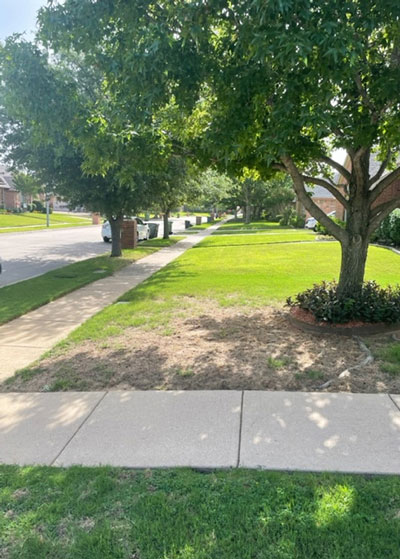
Answer: Bermuda needs 7 or 8 hours of direct sunlight per day to hold its own, more to grow vigorously. This looks like it might be marginal. If you have tried new sod and had it fail, I’d guess that it’s too much shade. And that will just get worse as the tree gets larger. Just to have mentioned it, Pythium (cottony blight) is the disease that could kill bermuda in this way, but this really doesn’t look like Pythium.
Question 18
WHAT IS WRONG WITH NEW GARDENIAS?
Question: Last December we planted Frostproof gardenias next to our 18-year-old gardenia. The new plants’ leaves are yellowing. What do we need to do? Kim M., Plano.

Answer: Resolution of the photo wouldn’t let me zoom in enough to tell if the plants might have gotten too dry or if they’re simply showing iron deficiency. Gardenias do best with morning sun and shade from late morning on. This looks like a rather extreme setting with possible extreme reflected sun and heat. They also need the same bed preparation you would give azaleas. (See answer to Question 12 above.)
